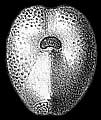The Echinoid Directory
Perispatangus Fourtau, 1905, p. 605
| Diagnostic Features |
|
|---|---|
| Distribution | Eocene, Egypt, Spain; ?Miocene, Mediterranean. |
| Name gender | masculine |
| Type | Euspatangus libycus de Loriol, 1881, p. 52 by original designation. |
| Species Included |
|
| Classification and/or Status | |
| Remarks | Fourtau distinguished this genus on account of its having the anterior paired petals set in a slight depression and the posterior petals flush. If the illustrations are to be believed, it can be distinguished from the closely related Eupatagus by its shallow but distinct anterior sulcus. It appears close to Mazettia in all details that are known and may be synonymous. |



